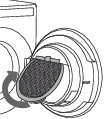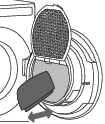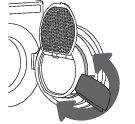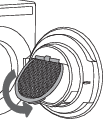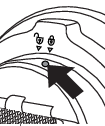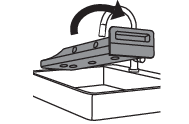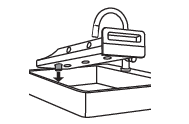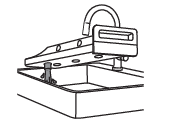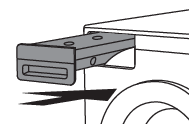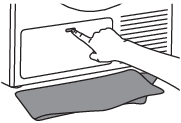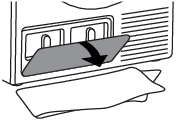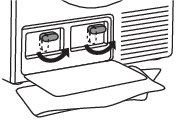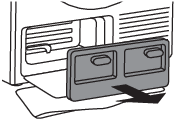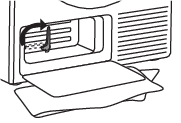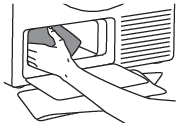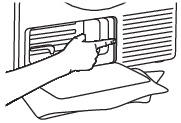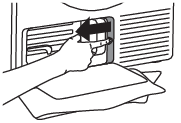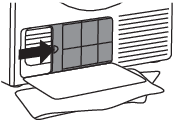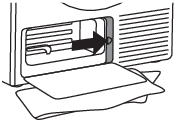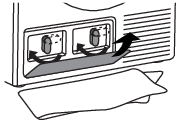
User Manual
Tumble dryer
TD75.C27X
TDC177XC
Carefully read the instructions for use before using the dryer.
Introduction
Dear Customer,
We thank you for purchasing this quality ASKO product.
We hope it meets all your expectations. Scandinavian design combines pure lines, everyday functionality, and high quality. These are the key characteristics of all our products, and the reason why they are highly appreciated across the globe.
We kindly recommend you to read these instructions before using the appliance for the first time. The instruction manual also includes information on how you can help protect the environment.
The following symbols are used throughout the manual and they have the following meanings:
Information, advice, tip, or recommendation
Warning – general danger
Warning – danger of electric shock
Warning – danger of hot surface
Warning – danger of fire
Original instructions
See Quick guide on the last page.
Safety precautions
General
Please read the instruction manual and save it for future reference.
-
Please do not use the tumble dryer if you have not read and understood these instructions or use first.
-
Failure to observe the instructions for use or inappropriate use of the tumble dryer may result in damage to the laundry or appliance, or injury to the user.
-
Instructions for use are available on our website at www.asko.com.
-
Appliance is intended to be used in an area open to the public.
-
Before connecting the dryer to the power mains, please read carefully the instructions for use that describe the dryer and its correct and safe use. The instructions apply to several appliance types or models; thus, settings or equipment may be described herein which is not available in your dryer.
-
Leave any repairs and similar tasks on the dryer to an expert. Unprofessional repair may result in an accident or major malfunction.
-
After installation, the dryer should stand still for two hours before it is connected to the power mains.
-
At least two persons are required to install the tumble dryer on top of a washing machine.
-
The dryer shall not be connected to the power mains using an extension cord.
-
Do not connect the tumble dryer to an electrical outlet intended for an electric shaver or hair dryer.
If the power cord is damaged, it has to be replaced by the manufacturer, an authorized service technician, or a similarly qualified person, in order to avoid any hazards.
-
The appliance shall not be supplied through an external switching device, such as a timer, or connected to a circuit that is regularly switched on and off by a utility.
-
After the drying process, unplug the dryer power cord from the power outlet.
If you have a tumble dryer with a 3-phase connection, do not pull the plug out of the power outlet.
-
The appliance shall be disconnected from the power source during servicing and replacement of parts. Removal of the plug has to be such, that an operator can check, from any of the points to which he has access that the plug remains removed.
-
In case of incorrect appliance connection, incorrect use, or servicing by an unauthorized person, the user shall bear the cost of any damage.
-
Air in the dryer environment should not contain dust particles. The air where the dryer is installed should be thoroughly ventilated to prevent reverse flow of gases released from the gas appliances with open fire (e.g. fireplaces).
-
Do not evacuate the air from the dryer through channels used for appliances or devices that use natural gas or other fuels for their operation (only applies to the evacuation dryer).
-
Clean the door net filter after each drying cycle.
-
Do not dry unwashed laundry in the dryer.
-
Laundry stained with oil, acetone, alcohol, oil derivatives, stain removers, turpentine, wax, and wax removers should be washed in a washing machine with hot water and detergent before it is dried in the dryer.
-
Clothing that includes latex, rubber parts, shower and bathing caps, and laundry or covers with rubber foam shall not be dried in the dryer.
-
Use laundry conditioners or similar products in compliance with manufacturer's instructions.
-
Do not use any solvents, abrasive cleaners, glass cleaners, or all-purpose cleaners.
-
Do not place the dryer behind lockable or sliding door, or door with a hinge on the opposite side of the dryer door hinge. Install the dryer in such way that the door can always be freely opened.
-
Never block the air vents.
-
Do not place the dryer on a carpet with long fibres as this may impede air circulation.
-
The air in the room where the dryer is installed may not contain dust particles.
-
Make sure the fibres do not accumulate around the dryer.
-
Remove all objects such as lighters and matches from the pockets.
-
After installation, wait for 24 hours before using the appliance. If the dryer has to be laid down on one of the sides during transport or servicing, place it with its left side, viewing from the appliance front, downwards (only applies to dryers with a heat pump).
-
The appliance shall not be in contact with a wall or adjacent furniture.
-
If the dryer is connected to an air exhaust system already used for another appliance, a non-return valve must be installed. Reverse flow into the dryer could damage the appliance, and the non-return valve prevents such reverse flow (only applies to the evacuation dryer).
-
A float will switch off the appliance if the condensed water pipe is clogged or if there is a risk of overflowing of the condensed water accumulated in the condensed water tank (only applies to the evacuation dryer).
-
If you wish to move the dryer or store it in a non-heated room during winter, it is essential that you first empty the condensed water tank (only applies to the condenser dryers and dryers with a heat pump).
-
Maximum drying capacity in kg is indicated on the rating plate.
Safety
-
Only use the dryer to dry laundry that was washed with water. Do not dry any laundry that was washed or cleaned with flammable cleaners or substances (such as gasoline, trichloroethylene etc.) as this may result in an explosion.
-
If you have cleaned your clothes with industrial cleaners or chemical substances, do not dry them in the dryer.
-
If the air exhaust hose is connected to an opening in the wall, influx of cool air may be prevented by installing a ventilation grille. (Only applies to evacuation dryer.) .
-
The air exhaust hose shall not be connected to an active chimney used to evacuate smoke or waste gases; into a shaft intended for ventilating rooms with combustion equipment; or into a chimney used by third parties. If smoke or waste gases return to the room where the dryer is installed, there is a danger of poisoning (only applies to evacuation dryer).
-
The dryer is protected with an automatic switch-off system in case of overheating. The system switches off the heater if the temperature is too high (only applies to evacuation and condenser dryer).
-
If the net filter is clogged, the automatic heater switch-off device can be triggered. See chapter "CLEANING AND MAINTENANCE" (only applies to evacuation and condenser dryer).
-
WARNING! The back of the dryer may get very hot during operation. Wait for the dryer to cool down completely before touching its back side. (Observe the instructions in the chapter "INSTALLATION AND CONNECTION")
-
Never stop a drying cycle or do not open the door before the end of the program. If you do so for any reason, be careful when taking the laundry from the drum as it can still be very hot and there is a risk of burning.
Quickly remove the laundry from the drum and spread it to allow it to cool down as quickly as possible.
Child safety
-
Do not allow the children to play with the dryer.
-
Prevent your children and pets from entering the dryer drum.
-
Before closing the dryer door and running the program, make sure there is nothing except laundry in the drum (e.g. if a child climbed into the dryer drum and closed the door from the inside).
-
Activate the child lock. See chapter: SETTINGS
-
Do not let children younger than three years to come near the dryer, unless they are under constant supervision.
-
The dryer is made in compliance with all relevant safety standards. This dryer may be used by children aged 8 years and above and by persons with reduced physical, sensory or mental capabilities or lack of experience and knowledge, but only if they are supervised during the use of the appliance, if they have been provided relevant instructions regarding safe use of the dryer, and if they understand the hazards of inappropriate use. Make sure children do not play with the appliance. Make sure the children do not clean the dryer or perform any maintenance tasks without supervision.
SAVE THESE INSTRUCTIONS FOR FUTURE REFERENCE!
Dryer description
|
|
|
Before using the appliance for the first time
Packaging
Remove all packaging.
Please sort the materials in compliance with local recommendations (see chapter "Disposal").
Cleaning
Disconnect the dryer from the power mains and open the door towards you. Before using the dryer for the first time, clean the dryer drum using a soft damp cotton cloth and water.
In the case of a 3 phase connection of the appliance, switch off the main socket switch.

No program can be started while the door is open.
Choosing the language
When the dryer is connected (see chapter "Installation and connection") and switched on for the first time, choose the preferred language.
For further drying process, see chapter "DRYING PROCESS, STEP BY STEP".
When you run the dryer for the first time, or if the dryer has been out of use for a long time, slight hitting noise may appear. This is normal and it will disappear after a few drying cycles.
Installation and connection
Dryer placement
The dryer can be either free standing or installed on top of a washing machine.
At least two persons are required to install the tumble dryer on top of a washing machine.
The dryer emits heat. Therefore, do not place it in a very small room, as the drying process may be longer due to limited amount of ambient air.
Do not place the dryer in a room where temperature can drop below 0 °C, as the machine may not operate correctly at such low temperatures, or freeze, which in turn can result in damage to the machine.
For optimum dryer operation, install it in a room with adequate ventilation and a temperature between 15 °C and 25 °C.
Do not place the dryer behind lockable or sliding door, or door with a hinge on the opposite side of the dryer door hinge. Install the dryer in such way that the door can always be freely opened.
Never block the air vents.
Do not place the dryer on a carpet with long fibres as this may impede air circulation.
If the appliance is installed on a plinth or a similar structure, then the appliance must be fixed to it, to avoid the risk of falling. ASKO original accessories are available for this purpose, complete with fixing instructions.

Free-standing appliance
|
|
The dryer may be placed adjacent to a washing machine. If the friction between the dryer feet and the floor is not sufficient, the dryer may move during operation. To prevent sliding, use a non-slide mat or install the supplied vacuum feet onto both front feet. |
|
|
Place the dryer so that it is stable. Use a spirit level to level the dryer in longitudinal
and traverse direction by rotating the adjustable feet using a No. 22 spanner (max.
15 mm). Then, firmly tighten the jam nuts (counter nuts) by rotating them towards
the appliance bottom using a No. 17 spanner |
Clearance around the dryer for optimum operation
|
|
The appliance shall not be in contact with a wall or adjacent furniture. For optimum dryer operation, observe the clearance from the wall as shown in Fig. |
Opening the dryer door (top view)
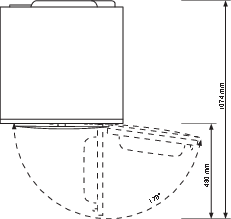
Stacking on top of a washing machine
To stack the dryer on top of a washing machine, use the extra vacuum feet and the tipping guard (A+B), supplied in the cardboard box in the dryer drum. Tipping guard part B is designed to fit on ASKO washing machines and it may be hard or impossible to mount on appliances of other brands. If the washing machine and dryer are not of matching dimensions or if you have installed a hidden helper between the two appliances, then binding plates are available as optional accessories at the service center (… available only for HH (acessory Hidden Helpers) and TD75 stacked on top of WM80 or WM85; not intended for any other combinations).
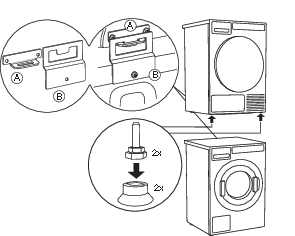
All ASKO washing machines can bear the weight of the dryer.
Washing machine on which you wish to install the dryer must be able to bear the weight of the dryer (see washing machine’s rating plate or technical information).
How to stack a dryer onto the washing machine (ASKO):
There is a cardboard box in the dryer drum, containing the vacuum feet and the tipping guard.
|
|
|
1 The tipping guard consists of two metal parts (A + B). Use two screws to attach the A part to the back of the dryer. |
|
|
2 Undo the screw on the back side of the washing machine. |
|
|
|
3 Use the screw to attach the tipping guard (B part) to the back of the washing machine. |
|
|
|
4 Level the washing machine so that it is stable.
|
|
|
|
5 Set the dryer feet:
|
|
|
|
6 Place the dryer onto the washing machine:
Make sure the tipping guard is "locked"! |
|
Changing the door opening direction
To change the direction of door opening, proceed as follows:
|
|
1 Open the door fully. |
|
|
|
2 Undo the screws and remove the door. |
|
|
|
3 Use a screwdriver to remove the door lock cover and undo the screw on the door lock. |
|
|
4 Push the door lock upwards and remove it. Move it to the other side and push it downwards. |
|
|
|
5 Fasten the screw on the door lock. Replace the door lock cover. |
|
|
6 Undo the door hinge assembly (left) and the door latch assembly (right), switch their positions, and replace the screws (door hinge assembly to the right-hand side, door latch assembly to the left-hand side). Use a screwdriver to remove the plastic part more easily. |
|
|
7 Undo the door ring and remove it temporarily. |
|
|
8 Rotate the door cover by 90°so that the sign indicating the opening of the door is on the other side. |
|
|
9 Rotate the door ring by 180°, install it onto the door, and fasten it with screws. |
|
|
|
10 Install the door to the front and screw the door. |
Draining the condensate
The moisture from the laundry is extracted in the condenser unit and accumulated in the condensate tank. Condensate tank has to be emptied regularly (see chapter "Cleaning and maintenance").
To simplified and avoid emptying and interruption of the drying cycle due to full condensate tank, run the condensate discharge tube located at the back of the appliance directly into a drain (see chapter "Settings/ Condensed water").
|
|
1 Remove the small short hose from the attachment (A). |
|
|
2 Connect the supplied drain hose to the same attachment (A). Run the condensate drain hose into a drain. Tie the hose onto a tap (B) so that it cannot slip during use. The drain hose can also be fed into the washbasin siphon (C) or directly into the floor drain (D). Then, the water is pumped directly into a washbasin, a siphon, or a floor drain. Do not pull the drain hose, and make sure it is not under tension, clamped, or bent. |
If you decide to run the condensate drain hose into a drain, siphon, or washbasin, make sure the hose is securely fastened. This will prevent any water spillage that could result in unexpected damage.
Always use hoses that are supplied with the appliance.
If the dryer is connected to an air exhaust system already used for another appliance, a non-return valve must be installed. Return flow into the dryer could damage the appliance and the non-return valve prevents such flow.
Connecting to the power mains
After installation, the dryer should stand still for two hours before it is connected to the power mains.
Connect the appliance to an earthed power outlet. After installation, the wall outlet should be freely accessible. The outlet should be fitted with an earth contact (in compliance with the relevant regulations).
If you have a tumble dryer with a 3 phase connection, the connection must be carried out by a qualified and authorized specialist.
Connection upon delivery

Information about your dryer is indicated on the rating (type) plate.
Use the type A differential current protection switch.
The dryer shall not be connected to the power mains using an extension cord.
Do not connect the tumble dryer to an electrical outlet intended for an electric shaver or hair dryer.
Any repair and maintenance pertaining to safety or performance should be done by trained experts.
Coin operation
(Only available in some models)
The machine is prepared for coin operation.
Owner/distributor can find detailed informations in Service manual.
Such installation must be carried out by a qualified professional.
The coin meter shall be able to short circuit two signal lines for periods of up to 10 minutes.
This will allow the user to load the appliance, choose a program and start the program after inserting the coins.
"Please pay to continue" appears on the display when the machine is started with the main power switch (by pressing on button Start).
Advices before drying
This chapter includes several advices on how to prepare the laundry from drying.
Laundry sorting
Sort the laundry according to:
-
type,
-
fabric thickness.
For the most even drying, make sure the laundry is made of a similar material.
Clothing
-
Close the buttons, zips, and hook-and-loop fasteners, so that they do not damage the fabric.
-
Turn the pockets inside out.
-
Place very sensitive clothes in a special-purpose laundry bag.
(The special purpose laundry bag is available as an optional accessory in general stores.)

Laundry to be dried in the dryer should be spun at a minimum of 1000 rpm. Higher spinning speeds will save energy and cut drying time.
If you decide to dry only one large item, we recommend drying it separately from smaller items of laundry.
Laundry symbols
Observe the laundry symbols.
Textile maintenance symbols:
|
|
||
|
Normal |
Delicate |
|
|
|
Max. washing temperature 90 °C |
|
|
|
Max. washing temperature 60 °C |
|
|
|
Max. washing temperature 40 °C |
|
|
|
Max. washing temperature 30 °C |
|
|
|
Hand wash only |
|
|
|
Do not wash |
|
|
|
||
|
|
Bleaching in cool water |
|
|
|
Bleaching not allowed |
|
|
|
||
|
|
Dry cleaning with all agents |
|
|
|
Perchloroethylene R11, R113, petroleum |
|
|
|
Dry cleaning in kerosene, pure alcohol, and R113 |
|
|
|
Dry cleaning not allowed |
|
|
|
||
|
|
Ironing with a hot iron with a maximum temperature of 200 °C |
|
|
|
Ironing with a hot iron with a maximum temperature of 150°C |
|
|
|
Ironing with a warm iron with a maximum temperature of 110°C |
|
|
|
Ironing not allowed |
|
|
|
||
|
|
Drying on a flat surface |
|
|
|
Drying without prior spinning |
|
|
|
Drying on a clothes line or a hanger |
|
|
|
||
|
|
Drying at high temperatures |
|
|
|
Drying at low temperatures |
|
|
|
Tumble drying not allowed |
|
Materials (fabrics) suitable for drying in a tumble dryer


 Material is suitable for tumble drying. Clothes dried in a tumble dryer will be softer
and lighter than air-dried clothes.
Material is suitable for tumble drying. Clothes dried in a tumble dryer will be softer
and lighter than air-dried clothes.
The dryer does not cause any considerable wear of the fabric. The lint collected in the lint filter consists of dust and fabric fragments collected during the use of the laundry.
Materials (fabrics) that may not be dried in a tumble dryer
 This symbol means that the material is not suitable for drying in a tumble dryer.
This symbol means that the material is not suitable for drying in a tumble dryer.
Never tumble dry the following:
-
clothing that was chemically cleaned (or dry-cleaned) at home,
-
foam,
-
glass fibres.
Drying process, step by step
STEP 1: Sort the fabrics
See chapter "Advices before drying"
Empty the pockets. Coins, nails etc. could damage the machine and the fabric.
STEP 2: Turn on the main switch.

Turning on
Press the  on/off button.
on/off button.
Switching off
Press the  on/off button.
on/off button.
STEP 3: Open the dryer door and insert the laundry.
Open the dryer door towards you.

Place the laundry into the empty dryer drum. Make sure there aren't any other objects among the laundry, such a detergent ball.
Such objects could melt and cause damage to the dryer or your laundry.
Do not overload the drum! (See program table and observe your nominal load as indicated on the rating plate.)
If the dryer drum is overloaded, the laundry will be more wrinkled and perhaps unevenly dried.
STEP 4: Choose the drying program.
Choose the program by rotating the program selector knob in either direction. Confirm the program selection by pressing the button under the program.

Select the program based on the type and remaining moisture of the laundry you wish to dry.
Anticipated program duration is indicated on the display.
Choose between the following programs:
(owner/distributor can change parameters and rename the program)
|
Programe (factory default program) |
Max. kg* |
Description |
|
|---|---|---|---|
|
|
AUTO EXTRA, Normal temp |
7 |
Use this program for non-sensitive cotton laundry. After drying, it will be completely dry and ready to be stored in the cupboard. |
|
|
AUTO EXTRA, Low temp |
7 |
Use this program for cotton laundry. After drying, it will be completely dry and ready to be stored in the cupboard. |
|
|
AUTO DRY, Normal temp |
7 |
Use this program for non-sensitive cotton laundry. After drying, it will be completely dry and ready to be stored in the cupboard. |
|
|
AUTO DRY, Low temp |
7 |
Use this program for cotton laundry. After drying, it will be completely dry and ready to be stored in the cupboard. |
|
|
AUTO NORMAL, Normal temp |
7 |
Use this program for non-sensitive cotton laundry of approximately the same thickness. After drying, it will be dry. |
|
|
AUTO NORMAL, Low temp |
7 |
Use this program for cotton laundry of approximately the same thickness. After drying, it will be dry. |
|
|
AUTO HAND IRON, Normal temp |
7 |
Use this program for cotton laundry. After drying, hand ironing is required. |
|
|
AUTO HAND IRON, Low temp |
7 |
Use this program for sensitive cotton laundry. After drying, hand ironing is required. |
|
|
AUTO MACHINE IRON, Normal temp |
7 |
Use this program for cotton laundry. After drying, machine ironing is required. |
|
|
AUTO MACHINE IRON, Low temp |
7 |
Use this program for sensitive cotton laundry. After drying, machine ironing is required. |
|
|
MIX DRY |
3,5 |
This program is used for synthetic or mixed fibre fabrics, such as multi-functional sport clothes. After drying, ironing is not required. |
|
|
MIX IRON |
3,5 |
This program is used for synthetic or mixed fibre fabrics. After drying, ironing is required. |
|
|
TIME 80 min |
4 |
Cycle will stop when set time is reached. The time program is suitable for small loads. |
|
|
TIME 60 min |
4 |
Cycle will stop when set time is reached. The time program is suitable for small loads. |
|
|
TIME 40 min |
4 |
Cycle will stop when set time is reached. The time program is suitable for small loads. |
|
|
TIME 20 min |
4 |
Cycle will stop when set time is reached. The time program is suitable for small loads. |
|
|
AIRING 60 min |
2 |
Use this program to just refresh or soften clothing. |
*Max. kg dry load
If your laundry is not dried to the desired dryness level, use a more suitable programme.
STEP 5: Choosing the program settings
Using the program settings, the drying programs can be further adjusted to your wishes. See chapter: SETTINGS.
Only appliance owner/distributor may change the settings!
Some program settings may not be available for your selected program.
Delay Start
In the submenu of the selected program, you can set the start delay when you want the drying program to start after a certain time (from 1 hour to 100 hours, from the time you press the Start / Pause button). The estimated time until the end of drying will be displayed.
Use the program selector knob to set from 1 h to 100 hours in 1-hour steps.
Press the button under the selected time/duration to confirm the setting.
Press the Startbutton to start. When the countdown reaches zero, the selected drying program will start automatically.
To cancel the start delay, press the button Cancel.
Then press the Start button to start the program.
During the countdown to the delayed start, the display will switch off after 5 minutes.
Use the program selector knob or press any button, to reactivate it. The countdown to the start of the drying cycle will be displayed.
Display will switch on 1 minute before the start of the drying cycle.
After the countdown, drying time will be indicated on the display unit.
STEP 6: Close the door and start the drying process.
Close the dryer door and press the Start/Pause button.

 Start (pressed briefly – start/resume)
Start (pressed briefly – start/resume)
 Pause (short press of the button - pause)
Pause (short press of the button - pause)
Stop (press and hold for 3 seconds – stop or cancel)
Remaining time
Depending on the selected program and load, anticipated drying time will be displayed in hours and minutes.
Actual drying time will depend on the selected program, load, type of laundry, spinning rate etc.
Actual drying time may be longer or shorter than initially displayed.
Pausing, stopping or changing the program
To pause a program, briefly press the Start/Pause button.
To resume the program, press the Start/Pause button again.
The drying program may also be paused by opening the dryer door.
To resume the programme, simply close the door and press the Start/Pause button.
To stop and cancel the drying program, press the Start/Pause button and hold it for 3 seconds.
The selected program will be stopped and the cooling stage will begin. Cooling time depends on the selected program.
Only after the cooling is complete, can you use the program selector knob to select a new program and press the Start/Pause button.
The final drying cycle includes a cooling down stage without heater operation. It makes sure the laundry is of suitable temperature at the end of the program and that it can be taken from the dryer without risk of touch hot clothes.
A drying program can be paused using the ON/OFF button.
The tumble dryer will switch off.
STEP 7: End of program
After the end of the drying program, the display will indicate that the drying has been finished.
If you have selected the "anti-crease" option, the dryer will continue to operate after the end of the drying cycle.
Open the door towards you and remove the laundry from the dryer.
Clean the net filter in the door (see chapter "Cleaning and maintenance").
Make sure the dryer drum is empty, then close the door.
5 minutes after the end of the program or last activation, the display will switch off to standby mode in order to save power.
The display will light up again if you press the ON/OFF button or open the dryer door.
After each drying cycle, clean the net filter in the door and empty the condensate tank. See chapter ”Cleaning and maintenance”.
A clogged net filter may result in activation of the automatic overheating switch-off device. Clean the filter, wait for the machine to cool down, and try running it again. If the dryer still fails to start, call a service technician.
After the drying process, unplug the dryer power cord from the power outlet.
If you have a tumble dryer with a 3-phase connection, do not pull the plug out of the power outlet.
Settings
Only appliance owner/distributor may change the settings!
(owner/distributor should check Service manual)
|
On display |
Setting |
Description |
|---|---|---|
|
Cleaning the filter |
On/Off |
|
|
Cleaning the door filter in the door |
1 --> 10 |
|
|
Cleaning of water condenser |
10 --> 100 |
(step 10) |
|
Condensed water |
Drain/Tank |
|
|
Payment system |
On/Off |
|
|
Heater 2 activation |
On/Off |
|
|
Change program |
On each program (some settings cannot be set on some programs) |
By changing settings it is possible to create and customize your own program. Programe can be renamed. |
|
0 --> 3 |
|
|
Switching on, (1h --> 4h) |
|
|
Override existing/Save as new |
|
|
Time program |
||
|
20 --> 240 min |
|
|
20 --> 240 min |
|
|
20 --> 240 min |
|
|
20 --> 240 min |
|
|
Override existing/Save as new |
|
|
Child Lock |
On/Off |
|
|
Programmes |
|
Selected program will be shown on display |
|
Set Language |
Select your language - press the button under the flag |
|
|
Temporary language selection |
On/Off |
(from 0 to 5) You can select up to 5 languages, which will be available in the main menu. |
|
Sound setting |
0 --> 5 |
|
|
Display settings: |
||
|
1 --> 5 |
|
|
On/Off |
|
|
Standby mode |
Normal/No standby |
|
|
Detailed view |
On/Off |
|
|
Demo mode |
On/Off |
|
|
Start delay |
On/Off |
1h --> 100h |
|
Time/Icon mode |
Time/Icon |
|
|
ID machine |
0 --> xxx |
|
|
WiFi settings |
By turning WiFi module On, the energy consumption will increase in standby mode. |
SOUNDS
(depending on the model)
In the initial stage of drying or during drying, the compressor and the pump may cause noise which, however, does not affect the dryer operation.
Humming sound: this is the sound of the compressor unit. The level of noise depends on the program and the drying stage.
Whirring sound: from time to time, the compressor unit is ventilated.
Pumping or liquid flowing sound: the pump is pumping the condensate into the condensate tank.
Clicking sound: clicking noise is caused by automatic cleaning of the heat exchanger (compressor).
Rustling water sound: can be heard during automatic cleaning.
Rattling sound: can be heard during drying if laundry has any hard parts (buttons, zippers etc.)
Cleaning and maintenance
Before cleaning, make sure to switch off the appliance and disconnect it from the power mains (unplug the power cord from the outlet).
Cleaning the door net filter in the door
Before cleaning, make sure to switch off the appliance and disconnect it from the power mains (unplug the power cord from the outlet).
|
|
1 Lift the net filter cover. |
|
|
2 By hand or a cloth drag the net filter to remove the lining of fibers and threads. The door net filter may feel quite loose when cleaning/removing fibers and threads. This is normal because of large net filter area in combination with high working temperatures inside the tumble dryer. |
|
|
3 If necessary, clean the net filter housing and door gasket as well. |
|
|
4 Close the net filter cover. |
|
|
5 If it is necessary to clean the net filter from the back, unscrew the screw and turn the filter from the locked to the unlocked position. Pull out the entire filter unit and clean it thoroughly, and return the filter unit to its original position after cleaning. Turn the filter from the unlocked to the locked position and tighten the screw. |
Make sure you do not pinch your fingers with the filter cover.
Clean the door net filter after each drying cycle.
Never operate without a door net filter or if the door net filter is damaged.
Emptying the condensate tank
Empty the condensate tank after each drying cycle.
If the condensate tank is overflowing the drying program will be paused automatically.
A warning will appear on the display unit that the condensate tank has to be emptied.
(Disregard this warning if you fed the condensate discharge hose into a drain, siphon, or a sink.)
|
|
|
1 Pull out the condensate tank from the dryer, then turn it upside down over a washbasin, sink, or any suitably sized vessel. |
|
|
|
2 Discharge the water through the condensate drain opening. To make draining the tank easier, pull out the nozzle at the condensate drain. Some water will still remain in the condensate tank, after emptying the water. |
|
|
3 Replace the condensate tank into the dryer housing. |
|
Water from the condensate tank is not drinkable. If thoroughly filtered, it can be used for ironing.
Never add chemicals or fragrances into the condensate tank.
Condensate tank does not require draining if the drain hose is connected directly to a washbasin or a bathroom floor drain (see chapter ”Installation and connection/Draining the condensate”).
Before moving the dryer or before storing it in a non-heated room during the winter, the condensate tank has to be emptied.
Water condenser clleaning
Clean the condenser when warning appears on the display.
Before cleaning, make sure to switch off the appliance and disconnect it from the power mains (unplug the power cord from the outlet).
|
|
|
1 During cleaning, some water may be spilled. It is therefore recommended to place an absorbent cloth on the floor. Open the outer cover. |
|
|
|
2 Hold the levers on the inside cover and rotate them upwards. Remove the inside cover. |
|
|
|
3 Rotate the condenser unit lever up. Use the handle to pull out the condenser unit. |
|
|
|
4 Rinse the condenser unit with a jet of lukewarm water on both sides, and drain well. Do not poke into the openings between the condenser unit ribs as this may damage the condenser unit. Do not wash the condenser unit in a dishwasher. |
|
|
|
5 Use a soft damp cloth to clean: – the area in front of the condenser unit where water usually accumulates, – the area behind the water condenser unit (reach deep into the opening all the way to the rear wall), – condenser unit housing, – all gaskets and sealing areas on the condenser unit housing and door. |
|
|
|
6 Press on the edge of the filter and pull it out. |
|
|
|
7 Rinse the filter under running water and then dry it. |
|
|
|
8 Insert the filter to the original position. |
|
|
|
9 Replace the condenser unit into the housing. Rotate the condenser unit lever down. Reinstall the inside cover and turn attachments to the locked position. Close the outer cover. |
The heat pump filter has to be correctly placed into its slot. Otherwise, the heat exchanger installed inside the dryer may be clogged.
Cleaning the appliance exterior
Clean the appliance exterior and the display unit using a soft damp cotton cloth and water. Do not use solvents or abrasive cleaners that could damage the appliance (please observe the recommendations and warnings provided by the manufacturers of the cleaning agents).
Wipe all parts of the dryer with a soft cloth until dry.
Keep the area around the dryer clean and cool. Dust, heat, and humidity will extend the drying time.
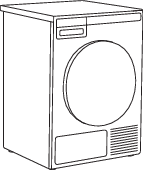
Always disconnect the dryer from the power mains before cleaning.
In the case of a 3 phase connection of the appliance, switch off the main socket switch.
Errors – what to do?
Disturbances from the environment (e.g. the power grid) may result in various error reports (see Troubleshooting table). In such case:
-
Switch off the appliance, wait for 1 minute, switch the appliance back on, and repeat the drying program.
-
If the error persists, call an authorized service center.
-
You will be able to solve most of the problems in appliance operation by yourself (see below Troubleshooting table ).
-
Repairs may only be carried out by an adequately trained person.
-
Repair or any warranty claim resulting from incorrect connection or use of the dryer shall not be covered by the warranty. In such cases, the costs of repair shall be charged to the user.
The warranty does not cover the errors or failures resulting from disturbances from the environment (lightning strike, power grid failures, natural disasters etc.).
|
Problem/error |
Cause |
What to do? |
|---|---|---|
|
The machine will not start. |
|
|
|
|
|
|
There is voltage in the outlet, but the drum does not spin ... The dryer does not work. |
|
|
|
|
|
|
|
|
|
|
|
|
The machine stops operating completely during a program. |
|
|
|
Laundry not dried or drying takes too long. |
|
|
|
|
|
|
|
|
|
|
|
|
|
|
|
Unevenly dried laundry. |
|
|
|
A slight hitting noise appears. |
|
|
|
The door opens during drying. |
|
|
Failure display
In case of a failure while a program is in progress, the relevant Error X is indicated on the display unit.
|
|
Press and hold the INFO button to display the error description. Switch off the dryer and turn it back on. |
Errors indicated on the display unit (depending on the model) may include the following:
|
Problem/error |
Error indication on the display |
What to do? |
|---|---|---|
|
E0 |
Control unit failure. |
Control unit failure. Call service centre. |
|
E1 |
Thermistor error. |
Temperature sensor failure. Call service centre. |
|
E2 |
Communication error. |
Communication error. Call service centre. |
|
E3 |
Pump error. |
Failure on the pump for pumping the condensate into the condensate tank Call service centre. |
|
E6 |
Relay failure. |
Control unit failure. Call service centre. |
|
E7 |
Door failure. |
Control unit failure. Call service centre. |
|
E8 |
Button failure. |
Control unit failure. Call service centre. |
|
E9 |
PB/UI software versions are not compatible. |
Call service centre. |
|
E10 |
EADBS communication error. |
Call service centre. |
|
E11 |
Motor communication error. |
Call service centre. |
INFORMATION before, during, and after the program
(depending on the model)
|
Error indication on the display |
What to do? |
|---|---|
|
EN:Please close the door before pressing start. |
Close the dryer door before starting or resuming the program. |
|
EN:Option not available at this phase of cycle. |
This option is not available. Select an option that is still available. |
|
EN:Cycle was interrupted by power failure. Please resume. |
Press the Start/Pause button to restart or resume the program. |
|
EN:Please empty the tank before resuming a cycle. |
See chapter "CLEANING AND MAINTENANCE". |
|
EN:Clean door filter. |
See chapter "CLEANING AND MAINTENANCE". |
|
EN:Clean the condenser unit. |
See chapter "CLEANING AND MAINTENANCE". |
|
EN:Please empty the water tank and clean door filter. |
See chapter "CLEANING AND MAINTENANCE". |
|
EN:Child lock is on. Press buttons for 3 sec to unlock. |
See chapter "SETTINGS". |
Service
Before calling a service technician
See the chapters "Troubleshooting and "Cleaning and maintenance" and see if you can resolve the problem yourself.
When you contact a service centre, please state the model (1), type (2), and serial number (3) of your dryer.
Model, type, and serial number are indicated on the rating (type) plate located on the interior side of the dryer door.
QR and AUID code are located on the inside of the drying machine door as well.
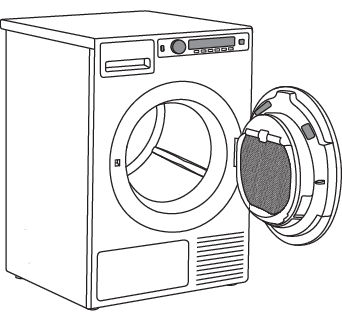
In case of a failure, only use approved spare parts by authorized manufacturers.
Repair or any warranty claim resulting from incorrect connection or use of the dryer shall not be covered by the warranty. In such cases, the costs of repair shall be charged to the user.

Technical information
Technical information
|
Height |
850 mm |
|
Width |
595 mm |
|
Depth |
654 mm |
|
Weight (net) |
45,0 kg |
|
Drum volume |
117 l |
|
Maximum drying load |
See rating plate |
|
Rated power |
See rating plate |
|
Drum material |
Stainless steel |
|
Housing material |
Hot-dip galvanized and powder coated sheet metal, or stainless steel sheet. |
Program chart
The table indicates the power consumption and time values for drying of a test batch of laundry with various loads and after spinning at various rates, consistently with the EN61121.
The following requirements apply to the consumption values specified below.
|
Inlet air temperature |
room temperature |
|
Inlet air humidity |
50–60% |
|
Drying temperature |
Normal |
TDC1772CB
|
Program |
Amount |
Spinning speed (rpm) |
Energy consumption, approximately (kWh)* |
Program duration, approximately (min)* |
|---|---|---|---|---|
|
AUTO EXTRA, Normal temp |
|
1400 |
4,60 |
155 |
|
|
1600 |
4,21 |
148 |
|
|
AUTO EXTRA, Low temp |
|
1400 |
5,50 |
250 |
|
AUTO DRY, Normal temp |
|
1400 |
3,95 |
130 |
|
|
1600 |
3,85 |
125 |
|
|
AUTO DRY, Low temp |
|
1400 |
4,20 |
175 |
|
AUTO NORMAL, Normal temp |
|
1000 |
4,25 |
135 |
|
|
1400 |
3,65 |
115 |
|
|
|
1600 |
3,28 |
111 |
|
|
AUTO NORMAL, Low temp |
|
1400 |
3,90 |
190 |
|
AUTO HAND IRON, Normal temp |
|
1400 |
3,30 |
105 |
|
|
1600 |
2,95 |
98 |
|
|
AUTO HAND IRON, Low temp |
|
1400 |
3,50 |
140 |
|
AUTO MACHINE IRON, Normal temp |
|
1000 |
3,30 |
110 |
|
|
1400 |
2,74 |
95 |
|
|
|
1600 |
2,36 |
79 |
|
|
AUTO MACHINE IRON, Low temp |
|
1400 |
2,82 |
120 |
|
MIX DRY |
|
1200 |
1,90 |
75 |
|
MIX IRON |
|
1000 |
1,50 |
55 |
|
|
full load (7 kg) |
|
|
partial load |
*Due to deviations in terms of type and amount of laundry, spinning, power supply oscillation, and environment temperature and humidity, the values measured at the user may differ from the one stated in the table.
Removal
Disposal / recycling of packaging
 Our product packaging is made of environmentally friendly materials that can be recycled,
disposed of, or destroyed without any hazard to the environment. To this end, packaging
materials are labelled appropriately.
Our product packaging is made of environmentally friendly materials that can be recycled,
disposed of, or destroyed without any hazard to the environment. To this end, packaging
materials are labelled appropriately.
The symbol on the product or its packaging indicates that the product should not be treated as normal household waste. Take the product to an authorized collection centre for waste electric and electronic equipment processing.
When disposing of an appliance, at the end of its useful life, remove all power cords and destroy the door latch and switch to prevent the door from locking or latching (child safety).
Correct disposal of the product will help prevent any negative effects on the environment and health of people which could occur in case of incorrect product removal. For detailed information on removal and processing of the product, please contact the relevant authority in charge of waste management, your waste disposal service, or the store where you bought the product.
NOTES
Quick guide
|
|
1. |
Sort the fabrics Sort the fabric by type and by how heavily soiled the laundry is. Observe the drying symbols on the laundry labels. Close the zippers, hook-and-loop fasteners and buttons. |
|
|
2. |
Switch on the main ON/OFF switch |
|
|
3. |
Open the dryer door and insert the laundry. Before doing so, make sure the drum is empty. |
|
|
4. |
Choose the drying program Turn the program selector knob to the desired drying program. |
|
|
5. |
Choose the program settings Program settings can be set for some programs. See chapter: SETTINGS |
|
|
6. |
Close the dryer door and press the Start/Pause BUTTON. Anticipated drying time, in hours and minutes, will be indicated on the display. |
|
|
7. |
End of program Open the door and remove the laundry from the dryer. Clean the filters. See chapter "CLEANING AND MAINTENANCE". Close the door. Switch off the main on/off switch. Unplug the dryer power cord from the power outlet (unless you have a tumble dryer with a 3phase connection) |
We reserve the right to make changes.

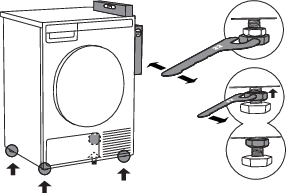
 .
.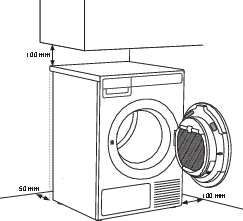

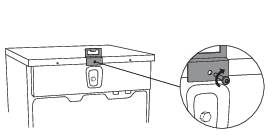
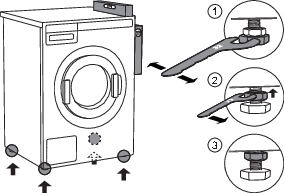
 .
.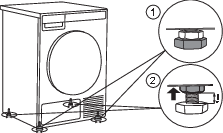
 .
.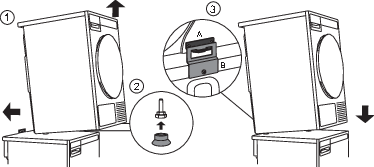
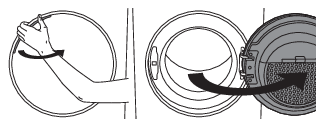
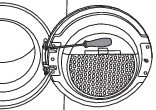
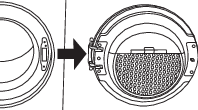
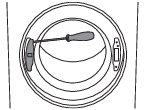


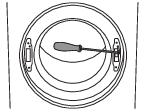
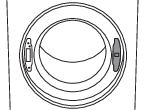



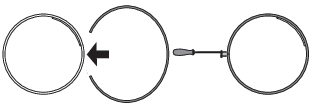

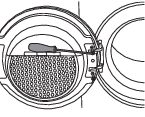





















































 /
/
